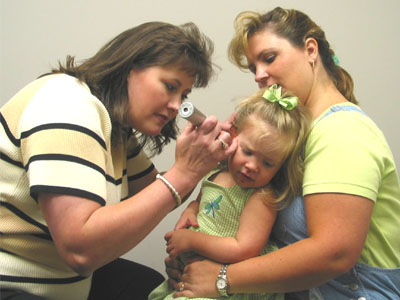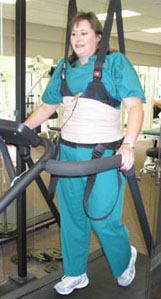BRANDON, Miss.—As a pediatrician with Rankin Children’s Group, Dr. Michelle VanNorman’s days are full of physical activity—from stooping to welcome shy toddlers to wrestling with reluctant patients.
So when VanNorman began experiencing back pain so severe she couldn’t even lift her own toddler, the mother of three knew she needed help. She found it at Methodist Rehabilitation Center’s east campus in Flowood, where doctors, psychologists and therapists work as a team to address the myriad causes of chronic back pain.
VanNorman said her initial back problems began in 1998. “I woke up one morning and couldn’t move and had surgery that day,” she said.
After that surgery removed a ruptured disc from her spine, VanNorman said she endured only occasional pain. “But about February, I had an episode I couldn’t get over. It was limiting what I could do, and I’m too young not to work.”
Dr. Rahul Vohra, medical director at Methodist Rehab, said VanNorman’s experience is typical of the patients he sees for chronic back pain. “Most seek treatment because their back pain limits their function.”
While many associate backaches with muscle strains, that’s rarely the cause among chronic pain sufferers, Vohra said “The pain usually comes from the joints and discs in the back,” he said. “You get muscle spasm secondary to that. Less commonly, you’ll see nerve irritation, which usually presents with leg and back pain.”
Estimates are that four out of five adults will experience at least one bout of back pain.
Common victims include people who do heavy labor, such as construction workers, truck drivers and factory workers.
“We also see a lot of sports injuries—primarily football and soccer,” Vohra said. “And we see a fair number of young people with back pain, such as teenage girls involved in gymnastics and cheerleading.”
One reason young people are experiencing back pain could be that the spine starts degenerating much earlier than other joints. “Recent studies have shown you can start seeing degenerative changes even in the teens,” Vohra said.
But that’s not to say back pain is inevitable. While a certain amount of wear and tear is unavoidable as you age, you can take steps to prevent back problems, Vohra said. He recommends regular exercise, proper lifting and moving techniques, maintaining a proper body weight, practicing proper posture and avoiding smoking.
Vohra said if you’re already experiencing recurrent back pain, the first step is to get a thorough biomechanical physical exam—preferably by health professionals who aren’t married to just one type of therapy or equipment.
“If all you’ve got is a hammer, everything looks like a nail,” he said. “You don’t want to go somewhere where everyone gets strapped in the same machine and does the same exercise.
“Patients very often require a combination of treatment. One of the unique things here is that the interaction between different specialties is so close. Within one building, we have neurosurgeons, pain physicians, physical medicine physicians, physical and occupational therapists and a pain psychologist.”
Like many who come to Methodist, VanNorman found relief through a combination of therapies. Epidural steroid injections to her lumbar region and sacroiliac joint eased her acute pain and allowed her to move on to sessions with physical therapist Karan Redditt.
Although she’s in a medical field herself, VanNorman said she wasn’t sure what to expect her first day in the physical therapy gym. But as Redditt led her through an exercise routine, VanNorman said she realized the therapeutic value of the supervised workout.
“I’m glad we have physical therapists to work with acute to chronic disabilities,” she said. “If you have someone who teaches you how to do an exercise and you feel comfortable doing it, it makes you more likely to succeed.”
And that’s true even outside the gym, VanNorman added. “I go home and do my exercises because I have someone to report to. Some nights I’ll be sitting …”
“And you hear my voice in your head,” Redditt joked.
VanNorman’s workout focuses on stretching and spinal stabilization exercises which are designed to relieve pain and restore function. “Dr. VanNorman has learned behaviors which compensate for her weaknesses and avoidance of painful movements,” Redditt said. “It has been a challenge for her to strengthen these areas of weakness, but the reward has been less pain and greater ease of function.”
Redditt also has taught VanNorman ways to do her daily activities that put less stress on her spine—such as sitting on a stool when doing exams or making sure she lifts objects using her legs.
“I really need to be flexible to examine kids,” VanNorman said. “Sometimes they are on the exam table and sometimes they’re in their parent’s lap. I have to get in strange positions just to look in their ears.”
VanNorman said as a result of therapy, she has been able to continue her work. And she also has learned the value of prescribing physical therapy for her own patients. “Not too long ago, I sent a child to physical therapy because he couldn’t keep up carrying his band instrument. It really did make a difference.”


